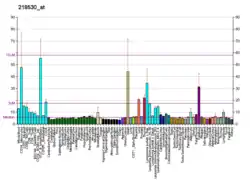FHOD1
FH1/FH2 domain-containing protein 1 is a protein that in humans is encoded by the FHOD1 gene.[3][4][5]
| FHOD1 | |||||||||||||||||||||||||||||||||||||||||||||||||||
|---|---|---|---|---|---|---|---|---|---|---|---|---|---|---|---|---|---|---|---|---|---|---|---|---|---|---|---|---|---|---|---|---|---|---|---|---|---|---|---|---|---|---|---|---|---|---|---|---|---|---|---|
| |||||||||||||||||||||||||||||||||||||||||||||||||||
| Identifiers | |||||||||||||||||||||||||||||||||||||||||||||||||||
| Aliases | FHOD1, FHOS, formin homology 2 domain containing 1 | ||||||||||||||||||||||||||||||||||||||||||||||||||
| External IDs | OMIM: 606881 HomoloGene: 40860 GeneCards: FHOD1 | ||||||||||||||||||||||||||||||||||||||||||||||||||
| |||||||||||||||||||||||||||||||||||||||||||||||||||
| |||||||||||||||||||||||||||||||||||||||||||||||||||
| |||||||||||||||||||||||||||||||||||||||||||||||||||
| |||||||||||||||||||||||||||||||||||||||||||||||||||
| Wikidata | |||||||||||||||||||||||||||||||||||||||||||||||||||
| |||||||||||||||||||||||||||||||||||||||||||||||||||
This gene encodes a protein which is a member of the formin/diaphanous family of proteins. The gene is ubiquitously expressed but is found in abundance in the spleen. The encoded protein has sequence homology to diaphanous and formin proteins within the Formin Homology (FH)1 and FH2 domains. It also contains a coiled-coil domain, a collagen-like domain, two nuclear localization signals, and several potential PKC and PKA phosphorylation sites. It is a predominantly cytoplasmic protein and is expressed in a variety of human cell lines.[5]
References
- GRCh38: Ensembl release 89: ENSG00000135723 - Ensembl, May 2017
- "Human PubMed Reference:". National Center for Biotechnology Information, U.S. National Library of Medicine.
- Westendorf JJ, Mernaugh R, Hiebert SW (May 1999). "Identification and characterization of a protein containing formin homology (FH1/FH2) domains". Gene. 232 (2): 173–82. doi:10.1016/S0378-1119(99)00127-4. PMID 10352228.
- Boehm MB, Milius TJ, Zhou Y, Westendorf JJ, Koka S (October 2005). "The mammalian formin FHOD1 interacts with the ERK MAP kinase pathway". Biochemical and Biophysical Research Communications. 335 (4): 1090–4. doi:10.1016/j.bbrc.2005.07.191. PMID 16112087.
- "Entrez Gene: FHOD1 formin homology 2 domain containing 1".
- Westendorf JJ (December 2001). "The formin/diaphanous-related protein, FHOS, interacts with Rac1 and activates transcription from the serum response element". The Journal of Biological Chemistry. 276 (49): 46453–9. doi:10.1074/jbc.M105162200. PMID 11590143.
Further reading
- Westendorf JJ (December 2001). "The formin/diaphanous-related protein, FHOS, interacts with Rac1 and activates transcription from the serum response element". The Journal of Biological Chemistry. 276 (49): 46453–9. doi:10.1074/jbc.M105162200. PMID 11590143.
- Koka S, Neudauer CL, Li X, Lewis RE, McCarthy JB, Westendorf JJ (May 2003). "The formin-homology-domain-containing protein FHOD1 enhances cell migration". Journal of Cell Science. 116 (Pt 9): 1745–55. doi:10.1242/jcs.00386. PMID 12665555.
- Gevaert K, Goethals M, Martens L, Van Damme J, Staes A, Thomas GR, Vandekerckhove J (May 2003). "Exploring proteomes and analyzing protein processing by mass spectrometric identification of sorted N-terminal peptides". Nature Biotechnology. 21 (5): 566–9. doi:10.1038/nbt810. PMID 12665801. S2CID 23783563.
- Tojo H, Kaieda I, Hattori H, Katayama N, Yoshimura K, Kakimoto S, et al. (July 2003). "The Formin family protein, formin homolog overexpressed in spleen, interacts with the insulin-responsive aminopeptidase and profilin IIa". Molecular Endocrinology. 17 (7): 1216–29. doi:10.1210/me.2003-0056. PMID 12677009.
- Takeya R, Sumimoto H (November 2003). "Fhos, a mammalian formin, directly binds to F-actin via a region N-terminal to the FH1 domain and forms a homotypic complex via the FH2 domain to promote actin fiber formation". Journal of Cell Science. 116 (Pt 22): 4567–75. doi:10.1242/jcs.00769. PMID 14576350.
- Lehner B, Semple JI, Brown SE, Counsell D, Campbell RD, Sanderson CM (January 2004). "Analysis of a high-throughput yeast two-hybrid system and its use to predict the function of intracellular proteins encoded within the human MHC class III region". Genomics. 83 (1): 153–67. doi:10.1016/S0888-7543(03)00235-0. PMID 14667819.
- Katoh M, Katoh M (April 2004). "Identification and characterization of human FHOD3 gene in silico". International Journal of Molecular Medicine. 13 (4): 615–20. doi:10.3892/ijmm.13.4.615. PMID 15010865.
- Wang Y, El-Zaru MR, Surks HK, Mendelsohn ME (June 2004). "Formin homology domain protein (FHOD1) is a cyclic GMP-dependent protein kinase I-binding protein and substrate in vascular smooth muscle cells". The Journal of Biological Chemistry. 279 (23): 24420–6. doi:10.1074/jbc.M313823200. PMID 15051728.
- Westendorf JJ, Koka S (May 2004). "Identification of FHOD1-binding proteins and mechanisms of FHOD1-regulated actin dynamics". Journal of Cellular Biochemistry. 92 (1): 29–41. doi:10.1002/jcb.20031. PMID 15095401. S2CID 40202935.
- Gill MB, Roecklein-Canfield J, Sage DR, Zambela-Soediono M, Longtine N, Uknis M, Fingeroth JD (June 2004). "EBV attachment stimulates FHOS/FHOD1 redistribution and co-aggregation with CD21: formin interactions with the cytoplasmic domain of human CD21". Journal of Cell Science. 117 (Pt 13): 2709–20. doi:10.1242/jcs.01113. PMID 15138285.
- Brandenberger R, Wei H, Zhang S, Lei S, Murage J, Fisk GJ, et al. (June 2004). "Transcriptome characterization elucidates signaling networks that control human ES cell growth and differentiation". Nature Biotechnology. 22 (6): 707–16. doi:10.1038/nbt971. PMID 15146197. S2CID 27764390.
- Lehner B, Sanderson CM (July 2004). "A protein interaction framework for human mRNA degradation". Genome Research. 14 (7): 1315–23. doi:10.1101/gr.2122004. PMC 442147. PMID 15231747.
- Beausoleil SA, Jedrychowski M, Schwartz D, Elias JE, Villén J, Li J, et al. (August 2004). "Large-scale characterization of HeLa cell nuclear phosphoproteins". Proceedings of the National Academy of Sciences of the United States of America. 101 (33): 12130–5. Bibcode:2004PNAS..10112130B. doi:10.1073/pnas.0404720101. PMC 514446. PMID 15302935.
- Madrid R, Gasteier JE, Bouchet J, Schröder S, Geyer M, Benichou S, Fackler OT (January 2005). "Oligomerization of the diaphanous-related formin FHOD1 requires a coiled-coil motif critical for its cytoskeletal and transcriptional activities". FEBS Letters. 579 (2): 441–8. doi:10.1016/j.febslet.2004.12.009. PMID 15642356. S2CID 23740212.
- Gasteier JE, Schroeder S, Muranyi W, Madrid R, Benichou S, Fackler OT (May 2005). "FHOD1 coordinates actin filament and microtubule alignment to mediate cell elongation". Experimental Cell Research. 306 (1): 192–202. doi:10.1016/j.yexcr.2005.02.006. PMID 15878344.
- Schönichen A, Alexander M, Gasteier JE, Cuesta FE, Fackler OT, Geyer M (February 2006). "Biochemical characterization of the diaphanous autoregulatory interaction in the formin homology protein FHOD1". The Journal of Biological Chemistry. 281 (8): 5084–93. doi:10.1074/jbc.M509226200. PMID 16361249.
This article is issued from Wikipedia. The text is licensed under Creative Commons - Attribution - Sharealike. Additional terms may apply for the media files.


